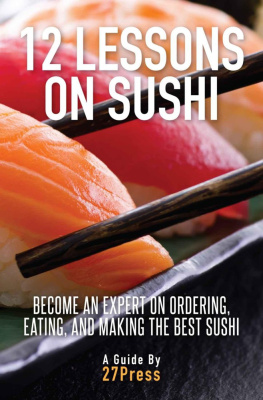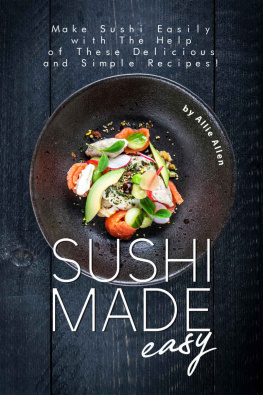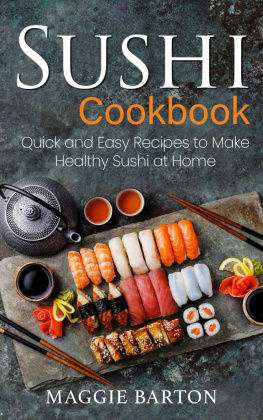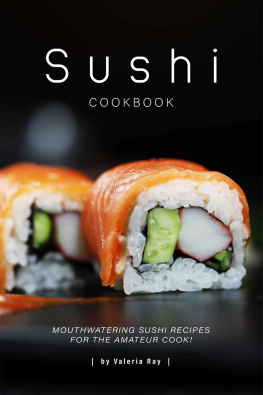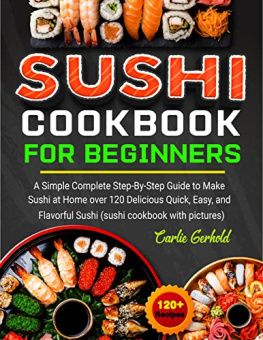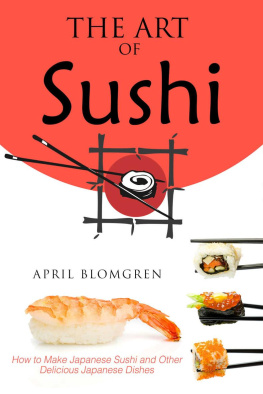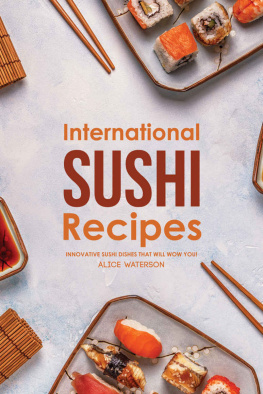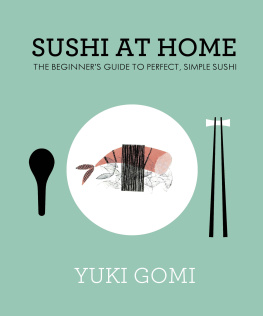12 Lessons On Sushi
Become an Expert on Ordering, Eating, and Making the Best Sushi
A Guide by
27Press
www.27press.com
12 Lessons On Sushi: Become an Expert on Ordering, Eating, and Making the Best Sushi
Copyright 2013 by 27Press
All rights reserved.
No part of this publication may be reproduced, distributed, or transmitted in any form or by any means, including photocopying, recording, or other electronic or mechanical methods, without the prior written permission of the publisher, except in the case of brief quotations embodied in critical reviews and certain other non-commercial uses permitted by copyright law.
For permission requests or information on quantity book discounts, please contact us through the information on our website.
Published by 27Press
www.27press.com
First Edition
November, 2013
ISBN-10: 0-9887705-4-7
ISBN-13: 978-0-9887705-4-6
v.0102
Disclaimer
Although the author, editors, and publisher have made every effort to ensure that the information in this book was correct at press time, the author, editors, and publisher do not assume and hereby disclaim any liability to any party for any loss, damage, or disruption caused by errors or omissions, whether such errors or omissions result from negligence, accident, or any other cause. This book is not intended as a substitute for the medical advice of physicians. The reader should regularly consult a physician in matters relating to his/her health and particularly with respect to any symptoms that may require diagnosis or medical attention.
Thank You
I want to extend a special thank you to everyone who helped with this book. Many people provided ideas, comments, edits, and suggestions along the way toward the completion of this project.
A few of those people are listed here in alphabetical order:
Ashley Jarvis Barrett
Kobe Kobayashi
Margaret Jarvis
Patrick Tinsley
Sarah Caragianis
Takeshi Trinitapoli
Wayne Conwell
Yoshitaka (Fred) Yamada
Thank you for all your help,
David J. Kosmider
Founder, 27Press
27Press
We produce excellent guides like this one on a variety of different topics.
10% of all author royalties are donated to awesome non-profit organizations.
Details available on our website.
www.27Press.com
Questions or comments? Email us:
news@27press.com
Contents
Introduction
I'm not making art, I'm making sushi.
-Masaharu Morimoto, Japanese Chef
Welcome to the world of sushi! This book will provide you with comprehensive knowledge on the topics of ordering, eating, making, and enjoying a variety of different traditional and modern types of sushi. Even if you have been eating sushi for years, you will likely pick up several new bits of knowledge along the way to help you enjoy sushi even more. While this book contains some information about Japanese culture, it's written primarily for American and European readers and focuses on what they might typically encounter in their local sushi restaurant.
Whether you are eating at your local sushi bar or you happen find yourself in a traditional Tokyo sushi-ya , the knowledge in this book will allow you to confidently enjoy the best sushi the world has to offer (and maybe even help you impress your friends and colleagues with your newfound knowledge of sushi along the way). Remember, this book is only the first part of a multi-step learning process. Only experiencing sushi for yourself will allow you to truly understand it. Starting out, you should try as many styles and types of sushi as you can get your hands on to find out what you like the most. Please also check out our online resources at the link below, it includes more links to additional information about sushi, including recommended additional reading, videos, and images, anything that is not easy to include in this book format.
Japanese Language
Japanese is written in characters, or logographs, which represent a word or meaning. One of the Japanese systems of writing is called Romaji, it is essentially a translation of Japanese words into Latin characters. In this book we have provided the Romaji spelling of many of the words associated with sushi so that Western readers can become familiar with them. The word sushi itself is the Romaji form of . For additional help with pronunciation of these terms, our online resources guide provides a list of important sushi-related terms along with links to native Japanese speakers saying each word.
To access the online resource guide, simply type the following shortened link into your browser's address bar and it will directly you to the page:
27Press.com/sushi
Enjoy!
Lesson 1
What is Sushi?
There's a lot of prep work in the rice. Making the rice is actually the most labor-intensive part of making sushi, but it's a very important step.
-Alice Yip
Any dish that includes the specially prepared sushi rice ( su-meshi ) is a type of sushi. It is the rice itself that makes something "sushi," not fish, as as is commonly believed in Western countries.
Sashimi, which is a dish of several pieces of sliced, raw fish, is commonly served before or with sushi, but is not "sushi" because it does not include any rice, more information about sashimi will be covered in Lesson 7.
In The Story of Sushi, Trevor Corson writes, "Japan's native religion, Shinto, starts with the belief that everythingtrees, foxes, fish, and samurai swordspossess it's own spirit... Rice seems especially sacred because it is Japan's staple food."
Rice is the second largest grain crop worldwide, behind wheat, and makes up a large part of the Japanese diet; approximately 30% of total food consumed. Though rice is a source of some protein, it's not a complete protein, and it is generally served with other proteins such as fish and meat.
Types of Rice
There are more than 40,000 varieties of rice grown throughout the world. Rice is categorized into long, medium, and short grains. Each has a different absorption rate and the cooking water is adjusted accordingly. Long grain rice tends to be fluffier and more fragrant and hold its shape better after cooking. Medium grain rice absorbs flavors well and becomes more sticky when cooked. It is used in dishes such as risotto and paella. Short grain rice, or Japanese rice, has a sweet aroma and firm sticky grains that hold flavors well. The stickiness also makes it a little easier to eat with chopsticks and holds ingredients better in dishes like sushi. Its sweet nutty flavor is excellent for sushi and puddings, and great all by itself as a side dish. Japanese rice is also used for sake production. Westerners frequently refer to Japanese rice as sushi rice.
Preparation
Great care is taken in sushi restaurants to make the perfect rice. Sushi rice has only a few ingredients; short-grain rice, water, sugar, salt, konbu (Japanese kelp), and rice vinegar. The sushi rice is cooked and then left to steam for about 15 minutes. The vinegar, with the sugar, salt, and konbu is then drizzled over the rice (in a non-metalic bowl, preferably wooden) and gently but thoroughly mixed with a wodden paddle, so as not to smash the grains but to coat the rice well.
While the basic recipe may seem simple, sushi chef apprentices spend years learning how to make the rice correctly. Typically, an apprentice spends about five years training with a master sushi chef before he is allowed to prepare the rice. Following very strict instructions, he will work diligently to refine his sushi rice until the master chef is satisfied. The preparation technique for each individual sushi-ya is a much coveted and prized secret. What really sets sushi restaurants apart, and is the backbone of any great sushi restaurant, is the caliber of its sushi rice. And simply put, great sushi rice is the result of years of hard work and formal training.
Next page
